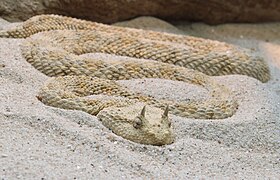Cerastes cerastes
| Cerastes cerastes | |
|---|---|

| |
| Phân loại khoa học | |
| Vực: | Eukaryota |
| Giới: | Animalia |
| Ngành: | Chordata |
| Lớp: | Reptilia |
| Bộ: | Squamata |
| Phân bộ: | Serpentes |
| Họ: | Viperidae |
| Chi: | Cerastes |
| Loài: | C. cerastes
|
| Danh pháp hai phần | |
| Cerastes cerastes (Linnaeus, 1758) | |
| Các đồng nghĩa[2] | |
| |
Cerastes cerastes là một loài rắn độc trong họ Rắn lục, bản địa các sa mạc bắc Phi và các khu vực ở Trung Đông. Nó thường dễ dàng được nhận ra bởi sự hiện diện của một cặp "sừng" siêu nhỏ, mặc dù các cá thể không sừng có hiện diện.[3] Hiện không có phân loài được công nhận.[4]. Loài này được Linnaeus mô tả khoa học đầu tiên năm 1758.[5]
Mô tả
[sửa | sửa mã nguồn]Chiều dài trung bình (thân và đuôi) 30–60 cm (12–24 in), với chiều dài tối đa 85 cm (33 in). Con cái lớn hơn con đực.[3]

Hình ảnh
[sửa | sửa mã nguồn]Chú thích
[sửa | sửa mã nguồn]- ^ Wagner, P., Wilms, T., Niagate, B., Joger, U., Geniez, P., Mateo, J.A., El Mouden, E.H., Slimani, T., Nouira, M.S., Baha El Din, S., Busais, S.M.S. & Al Jumaily, M.M. (2021). “Cerastes cerastes”. Sách đỏ IUCN về các loài bị đe dọa. 2021: e.T197465A2486896. doi:10.2305/IUCN.UK.2021-3.RLTS.T197465A2486896.en. Truy cập ngày 21 tháng 2 năm 2022.Quản lý CS1: sử dụng tham số tác giả (liên kết)
- ^ McDiarmid RW, Campbell JA, Touré T. (1999). Snake Species of the World: A Taxonomic and Geographic Reference, Volume 1. Washington, District of Columbia: Herpetologists' League. ISBN 1-893777-01-4.
- ^ a b Mallow D, Ludwig D, Nilson G. (2003). True Vipers: Natural History and Toxinology of Old World Vipers. Malabar, Florida: Krieger Publishing Company. ISBN 0-89464-877-2.
- ^ Cerastes cerastes (TSN 634963) tại Hệ thống Thông tin Phân loại Tích hợp (ITIS).
- ^ “Cerastes cerastes”. The Reptile Database. Truy cập ngày 29 tháng 5 năm 2013.
Tham khảo
[sửa | sửa mã nguồn]Wikispecies có thông tin sinh học về Cerastes cerastes
Wikimedia Commons có thêm hình ảnh và phương tiện truyền tải về Cerastes cerastes.
- Boulenger GA. 1896. Catalogue of the Snakes in the British Museum (Natural History). Volume III., Containing the...Viperidæ. London: Trustees of the British Museum (Natural History). (Taylor and Francis, printers). xiv + 727 pp. + Plates I.- XXV. (Cerastes cornutus, pp. 502–503).
- Calmette A. 1907. Les venins, les animaux venimeux et la serotherapie antivenimeuse. In: Bucherl W. editor. 1967. Venomous Animals and Their Venoms. Vol. I. Paris: Masson. 233 pp.
- Mohamed AH, Kamel A, Ayobe MH. 1969. "Studies of phospholipase A and B activities of Egyptian snake venoms and a scorpion venom". Toxicon 6: 293–988.
- Joger U. 1984. The Venomous Snakes of the Near and Middle East. Wiesbaden: Dr. Ludwig Reichert Verlag. 175 pp.
- Labib RS, Malim HY, Farag NW. 1979. "Fractionation of Cerastes cerastes and Cerastes vipera snake venoms by gel filtration and identification of some enzymatic and biological activities". Toxicon 17: 337–345.
- Labib RS, Azab MH, Farag NW. 1981. "Effects of Cerastes cerastes (Egyptian sand viper) snake venoms on blood coagulation: separation of coagulant and anticoagulant factors and their correlation with arginineesterase protease activities". Toxicon 19: 85–94.
- Labib RS, Azab ER, Farag NW. 1981. "Proteases of Cerastes cerastes and Cerastes vipera snake venoms". Toxicon 19: 73–83.
- Linnaeus C. 1758. Systema naturæ per regna tria naturæ, secundum classes, ordines, genera, species, cum characteribus, differentiis, synonymis, locis. Tomus I. Editio Decima, Reformata. Stockholm: L. Salvius. 824 pp. (Coluber cerastes, p. 217).
- Schneemann M, Cathomas R, Laidlaw ST, El Nahas AM, Theakston RDG, Warrell DA. 2004. "Life-threatening envenoming by the Saharan horned viper (Cerastes cerastes) causing micro-angiopathic haemolysis, coagulopathy and acute renal failure: clinical cases and review". Association of Physicians. QJM 97 (11): 717–727. Full text at Oxford Journals. Accessed 9 March 2007.
- Schnurrenburger H. 1959. "Observations on behavior in two Libyan species of viperine snake". Herpetologica 15:70-2.
- Cerastes cerastes tại Reptarium.cz Cơ sở dữ liệu lớp Bò sát. Truy cập 2 August 2007.
- Exceptional photo sequence of Cerastes cerastes feeding in the wild at FJ Expeditions taken on 27 October 2004. Accessed 19 October 2013.
- Sand viper page at Plumed-serpent.com. Accessed 30 July 2006.
- Video of Cerastes cerastes trên YouTube. Accessed 31 May 2007.
- Aziz Subach, Arik Dorfman, Bar Avidov, Adi Domer, Yehonatan Samocha and Inon Scharf. 2022 Foraging behaviour, habitat use and population size of the desert horned viper in the Negev desert. Royal Society Open Science https://doi.org/10.1098/rsos.220326
- Dorfman, A., Subach, A., & Scharf, I. (2023). Snakes on a slope: strong anti-gravitactic responses and differential habitat use in the Saharan horned viper (Cerastes cerastes) in the Negev desert. Royal Society Open Science, 10(3), 221652.https://doi.org/10.1098/rsos.221652
Chúng tôi bán
 GIẢM
10%
GIẢM
10%
171.000 ₫
190.000 ₫
 GIẢM
50%
GIẢM
50%
99.000 ₫
198.000 ₫
 GIẢM
39%
GIẢM
39%
7.300.000 ₫
12.000.000 ₫
 GIẢM
24%
GIẢM
24%
75.000 ₫
99.000 ₫
 GIẢM
21%
GIẢM
21%
550.000 ₫
700.000 ₫
 GIẢM
17%
GIẢM
17%
50.000 ₫
60.000 ₫








